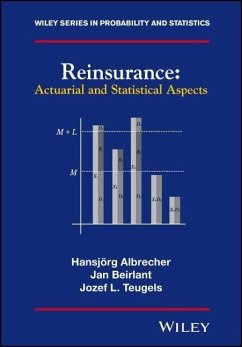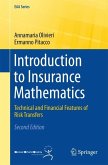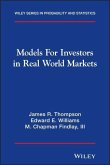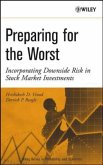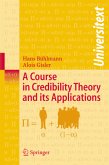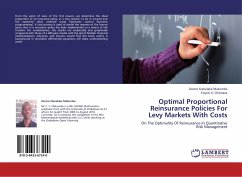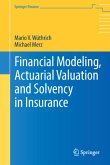Hansjorg Albrecher (Technische Universitat Graz, Jan Beirlant, Jozef L. Teugels (Catholic University of Leuven
Reinsurance
Actuarial and Statistical Aspects
Hansjorg Albrecher (Technische Universitat Graz, Jan Beirlant, Jozef L. Teugels (Catholic University of Leuven
Reinsurance
Actuarial and Statistical Aspects
- Gebundenes Buch
- Merkliste
- Auf die Merkliste
- Bewerten Bewerten
- Teilen
- Produkt teilen
- Produkterinnerung
- Produkterinnerung
Reinsurance: Actuarial and Statistical Aspects provides a survey of both the academic literature in the field as well as challenges appearing in reinsurance practice and puts the two in perspective. The book is written for researchers with an interest in reinsurance problems, for graduate students with a basic knowledge of probability and statistics as well as for reinsurance practitioners. The focus of the book is on modelling together with the statistical challenges that go along with it. The discussed statistical approaches are illustrated alongside six case studies of insurance loss data…mehr
Andere Kunden interessierten sich auch für
![Introduction to Insurance Mathematics Introduction to Insurance Mathematics]() Annamaria OlivieriIntroduction to Insurance Mathematics66,99 €
Annamaria OlivieriIntroduction to Insurance Mathematics66,99 €![Models for Investors in Real World Markets Models for Investors in Real World Markets]() James R. ThompsonModels for Investors in Real World Markets192,99 €
James R. ThompsonModels for Investors in Real World Markets192,99 €![Preparing for the Worst Preparing for the Worst]() Hrishikesh Vinod (Rick)Preparing for the Worst183,99 €
Hrishikesh Vinod (Rick)Preparing for the Worst183,99 €![Non-Life Insurance Mathematics Non-Life Insurance Mathematics]() Erwin StraubNon-Life Insurance Mathematics40,99 €
Erwin StraubNon-Life Insurance Mathematics40,99 €![A Course in Credibility Theory and its Applications A Course in Credibility Theory and its Applications]() Hans BühlmannA Course in Credibility Theory and its Applications55,99 €
Hans BühlmannA Course in Credibility Theory and its Applications55,99 €![Optimal Proportional Reinsurance Policies For Levy Markets With Costs Optimal Proportional Reinsurance Policies For Levy Markets With Costs]() Zororo S. MakumbeOptimal Proportional Reinsurance Policies For Levy Markets With Costs33,99 €
Zororo S. MakumbeOptimal Proportional Reinsurance Policies For Levy Markets With Costs33,99 €![Financial Modeling, Actuarial Valuation and Solvency in Insurance Financial Modeling, Actuarial Valuation and Solvency in Insurance]() Mario V. WüthrichFinancial Modeling, Actuarial Valuation and Solvency in Insurance102,99 €
Mario V. WüthrichFinancial Modeling, Actuarial Valuation and Solvency in Insurance102,99 €-
-
-
Reinsurance: Actuarial and Statistical Aspects provides a survey of both the academic literature in the field as well as challenges appearing in reinsurance practice and puts the two in perspective. The book is written for researchers with an interest in reinsurance problems, for graduate students with a basic knowledge of probability and statistics as well as for reinsurance practitioners. The focus of the book is on modelling together with the statistical challenges that go along with it. The discussed statistical approaches are illustrated alongside six case studies of insurance loss data sets, ranging from MTPL over fire to storm and flood loss data. Some of the presented material also contains new results that have not yet been published in the research literature. An extensive bibliography provides readers with links for further study.
Hinweis: Dieser Artikel kann nur an eine deutsche Lieferadresse ausgeliefert werden.
Hinweis: Dieser Artikel kann nur an eine deutsche Lieferadresse ausgeliefert werden.
Produktdetails
- Produktdetails
- Verlag: John Wiley & Sons / John Wiley & Sons Inc
- Seitenzahl: 368
- Erscheinungstermin: 3. November 2017
- Englisch
- Abmessung: 252mm x 177mm x 25mm
- Gewicht: 700g
- ISBN-13: 9780470772683
- ISBN-10: 0470772689
- Artikelnr.: 43614535
- Herstellerkennzeichnung
- Libri GmbH
- Europaallee 1
- 36244 Bad Hersfeld
- gpsr@libri.de
- Verlag: John Wiley & Sons / John Wiley & Sons Inc
- Seitenzahl: 368
- Erscheinungstermin: 3. November 2017
- Englisch
- Abmessung: 252mm x 177mm x 25mm
- Gewicht: 700g
- ISBN-13: 9780470772683
- ISBN-10: 0470772689
- Artikelnr.: 43614535
- Herstellerkennzeichnung
- Libri GmbH
- Europaallee 1
- 36244 Bad Hersfeld
- gpsr@libri.de
Hansjörg Albrecher, PhD, is a professor in the Department of Actuarial Science at the University of Lausanne. Jan Beirlant, PhD, is a professor in the Department of Mathematics at the Katholieke Universiteit Leuven, Belgium and at the University of the Free State, South Africa. Jozef L. Teugels, PhD, is a professor in the Department of Mathematics at the Katholieke Universiteit Leuven, Belgium.
Preface ix
1 Introduction 1
1.1 What is Reinsurance? 1
1.2 Why Reinsurance? 2
1.3 Reinsurance Data 4
1.3.1 Case Study I: Motor Liability Data 5
1.3.2 Case Study II: Dutch Fire Insurance Data 10
1.3.3 Case Study III: Austrian Storm Claim Data 10
1.3.4 Case Study IV: European Flood Risk Data 11
1.3.5 Case Study V: Groningen Earthquakes 12
1.3.6 Case Study VI: Danish Fire Insurance Data 12
1.4 Notes and Bibliography 16
2 Reinsurance Forms and their Properties 19
2.1 Quota-share Reinsurance 19
2.1.1 Some Practical Considerations 20
2.2 Surplus Reinsurance 21
2.3 Excess-of-loss Reinsurance 24
2.3.1 Moment Calculations 25
2.3.2 Reinstatements 27
2.3.3 Further Practical Considerations 29
2.4 Stop-loss Reinsurance 30
2.5 Large Claim Reinsurance 31
2.6 Combinations of Reinsurance Forms and Global Protections 32
2.7 Facultative Contracts 33
2.8 Notes and Bibliography 33
3 Models for Claim Sizes 35
3.1 Tails of Distributions 35
3.2 Large Claims 36
3.3 Common Claim Size Distributions 40
3.3.1 Light-tailed Models 41
3.3.2 Heavy-tailed Models 44
3.4 Mean Excess Analysis 49
3.5 Full Models: Splicing 50
3.6 Multivariate Modelling of Large Claims 52
4 Statistics for Claim Sizes 59
4.1 Heavy or Light Tails: QQ- and Derivative Plots 60
4.2 Large Claims Modelling through Extreme Value Analysis
EVA for Pareto-type Tails 63
4.2.1 EVA for Pareto-type Tails 63
4.2.2 General Tail Modelling using EVA 82
4.2.3 EVA under Upper-truncation 91
4.3 Global Fits: Splicing, Upper-truncation and Interval Censoring 97
4.3.1 Tail-mixed Erlang Splicing 97
4.3.2 Tail-mixed Erlang Splicing under Censoring and Upper-truncation 99
4.4 Incorporating Covariate Information 114
4.4.1 Pareto-type Modelling 114
4.4.2 Generalized Pareto Modelling 116
4.4.3 Regression Extremes with Censored Data 119
4.5 Multivariate Analysis of Claim Distributions 123
4.5.1 The Multivariate POT Approach 124
4.5.2 Multivariate Mixtures of Erlangs 125
4.6 Estimation of Other Tail Characteristics 128
4.7 Further Case Studies 132
4.8 Notes and Bibliography 137
5 Models for Claim Counts 139
5.1 General Treatment 139
5.1.1 Main Properties of the Claim Number Process 140
5.2 The Poisson Process and its Extensions 141
5.2.1 The Homogeneous Poisson Process 141
5.2.2 Inhomogeneous Poisson Processes 143
5.2.3 Mixed Poisson Processes 144
5.2.4 Doubly Stochastic Poisson Processes 149
5.3 Other Claim Number Processes 157
5.3.1 The Nearly Mixed Poisson Model 157
5.3.2 In¿nitely Divisible Processes 158
5.3.3 The Renewal Model 160
5.3.4 Markov Models 161
5.4 Discrete Claim Counts 161
5.5 Statistics of Claim Counts 164
5.5.1 Modelling Yearly Claim Counts 164
5.5.2 Modelling the Claim Arrival Process 172
5.6 Claim Numbers under Reinsurance 183
5.6.1 Number of Claims under Excess-loss Reinsurance 183
5.7Notes and Bibliography 187
6 Total Claim Amount 189
6.1 General Formulas for Aggregating Independent Risks 189
6.2 Classical Approximations for the Total Claim Size 191
6.2.1 Approximations based on the First Few Moments 191
6.2.2 Asymptotic Approximations for Light-tailed Claims 193
6.2.3 Asymptotic Approximations for Heavy-tailed Claims 198
6.3 Panjer Recursion 199
6.4 Fast Fourier Transform 200
6.5 Total Claim Amount under Reinsurance 201
6.5.1 Proportional Reinsurance 201
6.5.2 Excess-loss Reinsurance 202
6.5.3 Stop-loss Reinsurance 204
6.6 Numerical Illustrations 206
6.7 Aggregation for Dependent Risks 208
6.8 Notes and Bibliography 212
7 Reinsurance Pricing 217
7.1 Classical Principles of Premium Calculation 219
7.2 Solvency Considerations 219
7.2.1 The Ruin Probability 223
7.2.2 One-year Time Horizon and Cost of Capital 226
7.3 Pricing Proportional Reinsurance 228
7.4 Pricing Non-proportional Reinsurance 229
7.4.1 Exposure Rating 229
7.4.2 Experience Rating 232
7.4.3 Aggregate Pure Premium 234
7.5 The Aggregate Risk Margin 235
7.6 Leading and Following Reinsurers 237
7.7 Notes and Bibliography 238
8 Choice of Reinsurance 241
8.1 Decision Criteria 243
8.2 Classical Optimality Results 245
8.2.1 Pareto-optimal Risk Sharing 245
8.2.2 Stochastic Ordering 247
8.2.3 Minimizing Retained Variance 248
8.2.4 Maximizing Expected Utility 251
8.2.5 Minimizing the Ruin Probability 253
8.2.6 Combining Reinsurance Treaties over Subportfolios
8.3 Solvency Constraints and Cost of Capital 259
8.4 Minimizing Other Risk Measures 261
8.5 Combining Reinsurance Treaties 262
8.6 Reinsurance Chains 263
8.7 Dynamic Reinsurance 264
8.8 Beyond Piecewise Linear Contracts 266
8.9 Notes and Bibliography 268
9 Simulation 273
9.1 The Monte Carlo Method 273
9.2 Variance Reduction Techniques 276
9.2.1 Conditional Monte Carlo 277
9.2.2 Importance Sampling 277
9.3 Quasi-Monte Carlo Techniques 283
9.4 Notes and Bibliography 288
10 Further Topics 291
10.1 More on Large Claim Reinsurance 291
10.1.1 The Ordered Claims 291
10.1.2 Large Claim Reinsurance 296
10.1.3 ECOMOR 298
10.2 Alternative Risk Transfer 300
10.2.1 Notes and Bibliography 304
10.3 Reinsurance and Finance 305
10.4 Catastrophic Risk 306
References 309
Index 347
1 Introduction 1
1.1 What is Reinsurance? 1
1.2 Why Reinsurance? 2
1.3 Reinsurance Data 4
1.3.1 Case Study I: Motor Liability Data 5
1.3.2 Case Study II: Dutch Fire Insurance Data 10
1.3.3 Case Study III: Austrian Storm Claim Data 10
1.3.4 Case Study IV: European Flood Risk Data 11
1.3.5 Case Study V: Groningen Earthquakes 12
1.3.6 Case Study VI: Danish Fire Insurance Data 12
1.4 Notes and Bibliography 16
2 Reinsurance Forms and their Properties 19
2.1 Quota-share Reinsurance 19
2.1.1 Some Practical Considerations 20
2.2 Surplus Reinsurance 21
2.3 Excess-of-loss Reinsurance 24
2.3.1 Moment Calculations 25
2.3.2 Reinstatements 27
2.3.3 Further Practical Considerations 29
2.4 Stop-loss Reinsurance 30
2.5 Large Claim Reinsurance 31
2.6 Combinations of Reinsurance Forms and Global Protections 32
2.7 Facultative Contracts 33
2.8 Notes and Bibliography 33
3 Models for Claim Sizes 35
3.1 Tails of Distributions 35
3.2 Large Claims 36
3.3 Common Claim Size Distributions 40
3.3.1 Light-tailed Models 41
3.3.2 Heavy-tailed Models 44
3.4 Mean Excess Analysis 49
3.5 Full Models: Splicing 50
3.6 Multivariate Modelling of Large Claims 52
4 Statistics for Claim Sizes 59
4.1 Heavy or Light Tails: QQ- and Derivative Plots 60
4.2 Large Claims Modelling through Extreme Value Analysis
EVA for Pareto-type Tails 63
4.2.1 EVA for Pareto-type Tails 63
4.2.2 General Tail Modelling using EVA 82
4.2.3 EVA under Upper-truncation 91
4.3 Global Fits: Splicing, Upper-truncation and Interval Censoring 97
4.3.1 Tail-mixed Erlang Splicing 97
4.3.2 Tail-mixed Erlang Splicing under Censoring and Upper-truncation 99
4.4 Incorporating Covariate Information 114
4.4.1 Pareto-type Modelling 114
4.4.2 Generalized Pareto Modelling 116
4.4.3 Regression Extremes with Censored Data 119
4.5 Multivariate Analysis of Claim Distributions 123
4.5.1 The Multivariate POT Approach 124
4.5.2 Multivariate Mixtures of Erlangs 125
4.6 Estimation of Other Tail Characteristics 128
4.7 Further Case Studies 132
4.8 Notes and Bibliography 137
5 Models for Claim Counts 139
5.1 General Treatment 139
5.1.1 Main Properties of the Claim Number Process 140
5.2 The Poisson Process and its Extensions 141
5.2.1 The Homogeneous Poisson Process 141
5.2.2 Inhomogeneous Poisson Processes 143
5.2.3 Mixed Poisson Processes 144
5.2.4 Doubly Stochastic Poisson Processes 149
5.3 Other Claim Number Processes 157
5.3.1 The Nearly Mixed Poisson Model 157
5.3.2 In¿nitely Divisible Processes 158
5.3.3 The Renewal Model 160
5.3.4 Markov Models 161
5.4 Discrete Claim Counts 161
5.5 Statistics of Claim Counts 164
5.5.1 Modelling Yearly Claim Counts 164
5.5.2 Modelling the Claim Arrival Process 172
5.6 Claim Numbers under Reinsurance 183
5.6.1 Number of Claims under Excess-loss Reinsurance 183
5.7Notes and Bibliography 187
6 Total Claim Amount 189
6.1 General Formulas for Aggregating Independent Risks 189
6.2 Classical Approximations for the Total Claim Size 191
6.2.1 Approximations based on the First Few Moments 191
6.2.2 Asymptotic Approximations for Light-tailed Claims 193
6.2.3 Asymptotic Approximations for Heavy-tailed Claims 198
6.3 Panjer Recursion 199
6.4 Fast Fourier Transform 200
6.5 Total Claim Amount under Reinsurance 201
6.5.1 Proportional Reinsurance 201
6.5.2 Excess-loss Reinsurance 202
6.5.3 Stop-loss Reinsurance 204
6.6 Numerical Illustrations 206
6.7 Aggregation for Dependent Risks 208
6.8 Notes and Bibliography 212
7 Reinsurance Pricing 217
7.1 Classical Principles of Premium Calculation 219
7.2 Solvency Considerations 219
7.2.1 The Ruin Probability 223
7.2.2 One-year Time Horizon and Cost of Capital 226
7.3 Pricing Proportional Reinsurance 228
7.4 Pricing Non-proportional Reinsurance 229
7.4.1 Exposure Rating 229
7.4.2 Experience Rating 232
7.4.3 Aggregate Pure Premium 234
7.5 The Aggregate Risk Margin 235
7.6 Leading and Following Reinsurers 237
7.7 Notes and Bibliography 238
8 Choice of Reinsurance 241
8.1 Decision Criteria 243
8.2 Classical Optimality Results 245
8.2.1 Pareto-optimal Risk Sharing 245
8.2.2 Stochastic Ordering 247
8.2.3 Minimizing Retained Variance 248
8.2.4 Maximizing Expected Utility 251
8.2.5 Minimizing the Ruin Probability 253
8.2.6 Combining Reinsurance Treaties over Subportfolios
8.3 Solvency Constraints and Cost of Capital 259
8.4 Minimizing Other Risk Measures 261
8.5 Combining Reinsurance Treaties 262
8.6 Reinsurance Chains 263
8.7 Dynamic Reinsurance 264
8.8 Beyond Piecewise Linear Contracts 266
8.9 Notes and Bibliography 268
9 Simulation 273
9.1 The Monte Carlo Method 273
9.2 Variance Reduction Techniques 276
9.2.1 Conditional Monte Carlo 277
9.2.2 Importance Sampling 277
9.3 Quasi-Monte Carlo Techniques 283
9.4 Notes and Bibliography 288
10 Further Topics 291
10.1 More on Large Claim Reinsurance 291
10.1.1 The Ordered Claims 291
10.1.2 Large Claim Reinsurance 296
10.1.3 ECOMOR 298
10.2 Alternative Risk Transfer 300
10.2.1 Notes and Bibliography 304
10.3 Reinsurance and Finance 305
10.4 Catastrophic Risk 306
References 309
Index 347
Preface ix
1 Introduction 1
1.1 What is Reinsurance? 1
1.2 Why Reinsurance? 2
1.3 Reinsurance Data 4
1.3.1 Case Study I: Motor Liability Data 5
1.3.2 Case Study II: Dutch Fire Insurance Data 10
1.3.3 Case Study III: Austrian Storm Claim Data 10
1.3.4 Case Study IV: European Flood Risk Data 11
1.3.5 Case Study V: Groningen Earthquakes 12
1.3.6 Case Study VI: Danish Fire Insurance Data 12
1.4 Notes and Bibliography 16
2 Reinsurance Forms and their Properties 19
2.1 Quota-share Reinsurance 19
2.1.1 Some Practical Considerations 20
2.2 Surplus Reinsurance 21
2.3 Excess-of-loss Reinsurance 24
2.3.1 Moment Calculations 25
2.3.2 Reinstatements 27
2.3.3 Further Practical Considerations 29
2.4 Stop-loss Reinsurance 30
2.5 Large Claim Reinsurance 31
2.6 Combinations of Reinsurance Forms and Global Protections 32
2.7 Facultative Contracts 33
2.8 Notes and Bibliography 33
3 Models for Claim Sizes 35
3.1 Tails of Distributions 35
3.2 Large Claims 36
3.3 Common Claim Size Distributions 40
3.3.1 Light-tailed Models 41
3.3.2 Heavy-tailed Models 44
3.4 Mean Excess Analysis 49
3.5 Full Models: Splicing 50
3.6 Multivariate Modelling of Large Claims 52
4 Statistics for Claim Sizes 59
4.1 Heavy or Light Tails: QQ- and Derivative Plots 60
4.2 Large Claims Modelling through Extreme Value Analysis
EVA for Pareto-type Tails 63
4.2.1 EVA for Pareto-type Tails 63
4.2.2 General Tail Modelling using EVA 82
4.2.3 EVA under Upper-truncation 91
4.3 Global Fits: Splicing, Upper-truncation and Interval Censoring 97
4.3.1 Tail-mixed Erlang Splicing 97
4.3.2 Tail-mixed Erlang Splicing under Censoring and Upper-truncation 99
4.4 Incorporating Covariate Information 114
4.4.1 Pareto-type Modelling 114
4.4.2 Generalized Pareto Modelling 116
4.4.3 Regression Extremes with Censored Data 119
4.5 Multivariate Analysis of Claim Distributions 123
4.5.1 The Multivariate POT Approach 124
4.5.2 Multivariate Mixtures of Erlangs 125
4.6 Estimation of Other Tail Characteristics 128
4.7 Further Case Studies 132
4.8 Notes and Bibliography 137
5 Models for Claim Counts 139
5.1 General Treatment 139
5.1.1 Main Properties of the Claim Number Process 140
5.2 The Poisson Process and its Extensions 141
5.2.1 The Homogeneous Poisson Process 141
5.2.2 Inhomogeneous Poisson Processes 143
5.2.3 Mixed Poisson Processes 144
5.2.4 Doubly Stochastic Poisson Processes 149
5.3 Other Claim Number Processes 157
5.3.1 The Nearly Mixed Poisson Model 157
5.3.2 In¿nitely Divisible Processes 158
5.3.3 The Renewal Model 160
5.3.4 Markov Models 161
5.4 Discrete Claim Counts 161
5.5 Statistics of Claim Counts 164
5.5.1 Modelling Yearly Claim Counts 164
5.5.2 Modelling the Claim Arrival Process 172
5.6 Claim Numbers under Reinsurance 183
5.6.1 Number of Claims under Excess-loss Reinsurance 183
5.7Notes and Bibliography 187
6 Total Claim Amount 189
6.1 General Formulas for Aggregating Independent Risks 189
6.2 Classical Approximations for the Total Claim Size 191
6.2.1 Approximations based on the First Few Moments 191
6.2.2 Asymptotic Approximations for Light-tailed Claims 193
6.2.3 Asymptotic Approximations for Heavy-tailed Claims 198
6.3 Panjer Recursion 199
6.4 Fast Fourier Transform 200
6.5 Total Claim Amount under Reinsurance 201
6.5.1 Proportional Reinsurance 201
6.5.2 Excess-loss Reinsurance 202
6.5.3 Stop-loss Reinsurance 204
6.6 Numerical Illustrations 206
6.7 Aggregation for Dependent Risks 208
6.8 Notes and Bibliography 212
7 Reinsurance Pricing 217
7.1 Classical Principles of Premium Calculation 219
7.2 Solvency Considerations 219
7.2.1 The Ruin Probability 223
7.2.2 One-year Time Horizon and Cost of Capital 226
7.3 Pricing Proportional Reinsurance 228
7.4 Pricing Non-proportional Reinsurance 229
7.4.1 Exposure Rating 229
7.4.2 Experience Rating 232
7.4.3 Aggregate Pure Premium 234
7.5 The Aggregate Risk Margin 235
7.6 Leading and Following Reinsurers 237
7.7 Notes and Bibliography 238
8 Choice of Reinsurance 241
8.1 Decision Criteria 243
8.2 Classical Optimality Results 245
8.2.1 Pareto-optimal Risk Sharing 245
8.2.2 Stochastic Ordering 247
8.2.3 Minimizing Retained Variance 248
8.2.4 Maximizing Expected Utility 251
8.2.5 Minimizing the Ruin Probability 253
8.2.6 Combining Reinsurance Treaties over Subportfolios
8.3 Solvency Constraints and Cost of Capital 259
8.4 Minimizing Other Risk Measures 261
8.5 Combining Reinsurance Treaties 262
8.6 Reinsurance Chains 263
8.7 Dynamic Reinsurance 264
8.8 Beyond Piecewise Linear Contracts 266
8.9 Notes and Bibliography 268
9 Simulation 273
9.1 The Monte Carlo Method 273
9.2 Variance Reduction Techniques 276
9.2.1 Conditional Monte Carlo 277
9.2.2 Importance Sampling 277
9.3 Quasi-Monte Carlo Techniques 283
9.4 Notes and Bibliography 288
10 Further Topics 291
10.1 More on Large Claim Reinsurance 291
10.1.1 The Ordered Claims 291
10.1.2 Large Claim Reinsurance 296
10.1.3 ECOMOR 298
10.2 Alternative Risk Transfer 300
10.2.1 Notes and Bibliography 304
10.3 Reinsurance and Finance 305
10.4 Catastrophic Risk 306
References 309
Index 347
1 Introduction 1
1.1 What is Reinsurance? 1
1.2 Why Reinsurance? 2
1.3 Reinsurance Data 4
1.3.1 Case Study I: Motor Liability Data 5
1.3.2 Case Study II: Dutch Fire Insurance Data 10
1.3.3 Case Study III: Austrian Storm Claim Data 10
1.3.4 Case Study IV: European Flood Risk Data 11
1.3.5 Case Study V: Groningen Earthquakes 12
1.3.6 Case Study VI: Danish Fire Insurance Data 12
1.4 Notes and Bibliography 16
2 Reinsurance Forms and their Properties 19
2.1 Quota-share Reinsurance 19
2.1.1 Some Practical Considerations 20
2.2 Surplus Reinsurance 21
2.3 Excess-of-loss Reinsurance 24
2.3.1 Moment Calculations 25
2.3.2 Reinstatements 27
2.3.3 Further Practical Considerations 29
2.4 Stop-loss Reinsurance 30
2.5 Large Claim Reinsurance 31
2.6 Combinations of Reinsurance Forms and Global Protections 32
2.7 Facultative Contracts 33
2.8 Notes and Bibliography 33
3 Models for Claim Sizes 35
3.1 Tails of Distributions 35
3.2 Large Claims 36
3.3 Common Claim Size Distributions 40
3.3.1 Light-tailed Models 41
3.3.2 Heavy-tailed Models 44
3.4 Mean Excess Analysis 49
3.5 Full Models: Splicing 50
3.6 Multivariate Modelling of Large Claims 52
4 Statistics for Claim Sizes 59
4.1 Heavy or Light Tails: QQ- and Derivative Plots 60
4.2 Large Claims Modelling through Extreme Value Analysis
EVA for Pareto-type Tails 63
4.2.1 EVA for Pareto-type Tails 63
4.2.2 General Tail Modelling using EVA 82
4.2.3 EVA under Upper-truncation 91
4.3 Global Fits: Splicing, Upper-truncation and Interval Censoring 97
4.3.1 Tail-mixed Erlang Splicing 97
4.3.2 Tail-mixed Erlang Splicing under Censoring and Upper-truncation 99
4.4 Incorporating Covariate Information 114
4.4.1 Pareto-type Modelling 114
4.4.2 Generalized Pareto Modelling 116
4.4.3 Regression Extremes with Censored Data 119
4.5 Multivariate Analysis of Claim Distributions 123
4.5.1 The Multivariate POT Approach 124
4.5.2 Multivariate Mixtures of Erlangs 125
4.6 Estimation of Other Tail Characteristics 128
4.7 Further Case Studies 132
4.8 Notes and Bibliography 137
5 Models for Claim Counts 139
5.1 General Treatment 139
5.1.1 Main Properties of the Claim Number Process 140
5.2 The Poisson Process and its Extensions 141
5.2.1 The Homogeneous Poisson Process 141
5.2.2 Inhomogeneous Poisson Processes 143
5.2.3 Mixed Poisson Processes 144
5.2.4 Doubly Stochastic Poisson Processes 149
5.3 Other Claim Number Processes 157
5.3.1 The Nearly Mixed Poisson Model 157
5.3.2 In¿nitely Divisible Processes 158
5.3.3 The Renewal Model 160
5.3.4 Markov Models 161
5.4 Discrete Claim Counts 161
5.5 Statistics of Claim Counts 164
5.5.1 Modelling Yearly Claim Counts 164
5.5.2 Modelling the Claim Arrival Process 172
5.6 Claim Numbers under Reinsurance 183
5.6.1 Number of Claims under Excess-loss Reinsurance 183
5.7Notes and Bibliography 187
6 Total Claim Amount 189
6.1 General Formulas for Aggregating Independent Risks 189
6.2 Classical Approximations for the Total Claim Size 191
6.2.1 Approximations based on the First Few Moments 191
6.2.2 Asymptotic Approximations for Light-tailed Claims 193
6.2.3 Asymptotic Approximations for Heavy-tailed Claims 198
6.3 Panjer Recursion 199
6.4 Fast Fourier Transform 200
6.5 Total Claim Amount under Reinsurance 201
6.5.1 Proportional Reinsurance 201
6.5.2 Excess-loss Reinsurance 202
6.5.3 Stop-loss Reinsurance 204
6.6 Numerical Illustrations 206
6.7 Aggregation for Dependent Risks 208
6.8 Notes and Bibliography 212
7 Reinsurance Pricing 217
7.1 Classical Principles of Premium Calculation 219
7.2 Solvency Considerations 219
7.2.1 The Ruin Probability 223
7.2.2 One-year Time Horizon and Cost of Capital 226
7.3 Pricing Proportional Reinsurance 228
7.4 Pricing Non-proportional Reinsurance 229
7.4.1 Exposure Rating 229
7.4.2 Experience Rating 232
7.4.3 Aggregate Pure Premium 234
7.5 The Aggregate Risk Margin 235
7.6 Leading and Following Reinsurers 237
7.7 Notes and Bibliography 238
8 Choice of Reinsurance 241
8.1 Decision Criteria 243
8.2 Classical Optimality Results 245
8.2.1 Pareto-optimal Risk Sharing 245
8.2.2 Stochastic Ordering 247
8.2.3 Minimizing Retained Variance 248
8.2.4 Maximizing Expected Utility 251
8.2.5 Minimizing the Ruin Probability 253
8.2.6 Combining Reinsurance Treaties over Subportfolios
8.3 Solvency Constraints and Cost of Capital 259
8.4 Minimizing Other Risk Measures 261
8.5 Combining Reinsurance Treaties 262
8.6 Reinsurance Chains 263
8.7 Dynamic Reinsurance 264
8.8 Beyond Piecewise Linear Contracts 266
8.9 Notes and Bibliography 268
9 Simulation 273
9.1 The Monte Carlo Method 273
9.2 Variance Reduction Techniques 276
9.2.1 Conditional Monte Carlo 277
9.2.2 Importance Sampling 277
9.3 Quasi-Monte Carlo Techniques 283
9.4 Notes and Bibliography 288
10 Further Topics 291
10.1 More on Large Claim Reinsurance 291
10.1.1 The Ordered Claims 291
10.1.2 Large Claim Reinsurance 296
10.1.3 ECOMOR 298
10.2 Alternative Risk Transfer 300
10.2.1 Notes and Bibliography 304
10.3 Reinsurance and Finance 305
10.4 Catastrophic Risk 306
References 309
Index 347

